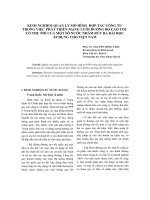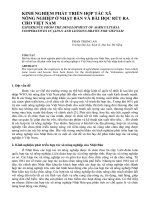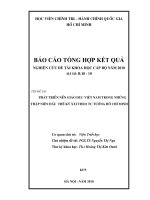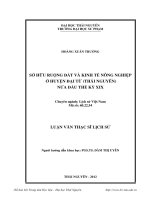Phát triển kinh tế nông thôn ở ba lan trong những thập niên đầu thế kỷ XXI và bài học kinh nghiệm cho việt nam tt tiếng anh
Bạn đang xem bản rút gọn của tài liệu. Xem và tải ngay bản đầy đủ của tài liệu tại đây (271.08 KB, 26 trang )
VIETNAM ACADEMY OF SOCIAL SCIENCES
GRADUATE ACADEMY OF SOCIAL SCIENCES
--------------------
BUI VIET HUNG
RURAL ECONOMIC DEVELOPMENT IN
POLAND IN THE EARLY DECADES OF THE
TWENTY –FIRST CENTURY AND LESSONS
LEARNED FOR VIETNAM
NỘI ĐỊA Ở ĐỒNG BẰNG SÔNG CỬU LONG
Major: International Economics
Code: 9. 31. 01. 06
ABSTRACT
Ph.D THESIS OF INTERNATIONAL ECONOMICS
HANOI - 2020
1
HÀ NỘI - 2018
Thesis is completed at
Vietnam Academy of Social Sciences
Science supervisors:
1. Assoc. Prof. Dr. Nguyen An Ha
2. Assoc. Prof . Dr.Dang Minh Duc
Reviewer 1: Prof. Dr. Do Duc Binh
Reviewer 2: Assoc.Prof. Dr.Trinh Thi Hoa Mai
Reviewer 3:: Assoc.Prof. Dr. Tran Thi Lan Huong
Thesis is to be defended at academy-level thesis appraisal council
assembled
at………..….o’clock…………,
dated………month……….year……………..
Reference of this thesis is available in:
- National Library of Vietnam;
- Library of Graduate Academy of Social Sciences
2
INTRODUCTION
1. Rationale
After becoming a member of the EU on May 1, 2004, the
Polish Government implemented a sweeping and comprehensive
reform, which strictly met EU accession standards on every aspect
such as concentrated on legal, political reforming, completing the
institutional framework of the market economy rapidly and
sustainably and narrowing the average income per capita gap in the
EU.
With the application of the new rural model theories, the
Polish rural area has gradually met the common EU standards in the
direction of competition, modernity and sustainable development.
The achieved results from the implementation of Poland's rural
economic development policies in recent years have created
impressive economic and social transformations in the rural area. To
be specific, the scale of the agricultural farm has been expanded, the
output of agricultural products and labor productivity are escalating,
etc. Besides, the adjustments in government policies have promoted
the diversification of the rural economy with the booming of nonagricultural enterprises, creating employment opportunities for rural
workers, furthering farmers' income rapidly and approaching that of
urban residents.
In Vietnam, over the past 30 years of renovation, the rural
economic sector has made obvious changes to the stability of
people's material, spiritual life and socio-economic infrastructure.
Agricultural production activities have achieved rapid and stable
growth for a long time, forming Vietnam a leading exporter of
agricultural products in the world. The policy of rural development
approaching the direction of “new rural” was accepted in 2008
1
through the Decision No. 26-NQ / TW dated August 5, 2008 in terms
of agriculture, farmers and rural areas of the Board of Executive
Central Committee X, creating a positive impact on improving the
lives of people in rural areas, etc.
However, in addition to the remarkable achievements, rural
economic development in Vietnam is facing challenges and
limitations. Many growth indicators are declining, support for
production expansion of cultivated land and other resources that have
been used to the limit. In addition, the population living on
agriculture still accounts for a too high proportion though contributes
less than 20% of GDP. As a result, the income gap between farmers
and urban residents is getting increasingly high, etc.
In the process of development, Vietnam needs to gain experiences
from countries with similar agricultural production and successful
rural economic development policies. On the basis of the mentioned
points and analyzing urgent issues, the author chooses the issue of
"Rural economic development in Poland in the early decades of the
twenty-first century and lessons learned for Vietnam” to do his thesis.
2. The purpose and task of the thesis research
2.1. Research purposes
The dissertation aims to clarify the theoretical issues about rural
economic development, analyzing and assessing the current situation
of rural economic development in Poland in the early decades of the
twenty-first century, evaluating the similarities and differences
specials and conditions applicable to Vietnam. On that basis, some
experiencing lessons and policy suggestions for Vietnam are drawn
in the coming time.
2.2. Research mission
The thesis focuses on performing the following tasks:
2
Firstly, review and systematize basic theoretical issues on rural
economic development of published research with the directlyrelated content. On that basis, point out theoretical and realistic
issues that the thesis needs to continue to study and clarify.
Secondly, research, assess and analyze the rural economic
development policies in Poland in the first decades of the twenty-first
century.
Thirdly, assess the similarities and the applicability of experience
lessons for Vietnam. The thesis proposes to suggest some
implications of policies for sustainable rural economic development
in Vietnam for the next period.
3. Object and scope of the thesis
3.1. Subject of the thesis research
The thesis focuses on the subject of rural economic
development in Poland from the perspective of agricultural and nonagricultural production activities in rural areas, the role of the Polish
government in promulgating, implementing policies and programs
for rural economic development.
3.2. Scope of the thesis research
Scope of content: The thesis studies rural economic
development issues in both theoretical and practical terms, focusing
on main contents such as: Agricultural production activities (in the
sense of narrow, excluding forestry and fisheries) and nonagricultural activities in rural Poland.
Scope of space: The thesis focuses deeply on analyzing and
evaluating the situation of rural economic development in Poland.
Scope of time: The early decades of the twenty-first century
focused on mainly from 2004 onwards (After Poland became a full
member of the European Union).
3
4. Methodology and research methods of the thesis
4.1. Methodology and research methods of the thesis
Based on the theoretical and methodological basis of
dialectical materialism and historical materialism in Marxist-Leninist
doctrine to consider the process of rural economic development in
Poland after Poland became Official member of the European Union.
4.1.2. Approach method
Historical approach: Consider the context of the EU's rural
development policy, the Polish rural development policy and this
policy objective to the Polish rural economic development program.
Systems
approach:
Consider
the
process
of
rural
development policy to the implementation of the Polish rural
economic development program.
Interdisciplinary approach: Rural development should be
considered and analyzed in the direction of an interdisciplinary
approach including: Economy, society and environment.
International
economics
approach:
Approaching
rural
economic activities in the dependence on regional development
policies, as well as determining the contribution of this sector to
Poland.
4.2. Specific research methods
4.2.1 Methods of data collection:
The dissertation approaches from secondary documents from
international organizations such as: European Commission, Polish
Ministry of Agriculture and Rural Development, researches of
European experts and other oversea experts, e-books information,
data of relevant agencies of some European countries and Vietnam in
all aspects related to rural economic development.
4
4.2.2. Data processing methods
The documents are gathered, translated (if they are foreign
language documents), sorted and classified according to each topic
and content in the analytical framework. The data that needs to be
statistically processed is entered into data and processed through
Excel software to form tables, charts and graphs.
Statistical, comparison, analysis and prediction method
Analyze statistics on Poland's socio-economic development
calculate the economic growth rate, the proportion of rural economy
in the national economy at different periods. The comparison method
is used to assess the difference among periods such as the increase or
decrease in agricultural production, rural labor, etc.
SWOT analysis method: This method shows the current
situation and influencing factors to the clearest. As a result, the
Government of Poland’s solutions in promoting their strengths,
taking advantage of opportunities and overcoming weaknesses in
rural economic development to deal with the challenges posed are
fully recognized.
5. New scientific contribution of the thesis
Theoretical: Completing the theoretical framework for rural
economic development, through clarifying theories of rural economic
development, factors affecting from outside and within the country,
and rural economic development evaluation criteria.
In practice: Analyze the current situation of Polish rural
economic development, evaluate the successes, limitations and
challenges posed in the rural economic development in Poland in the
early decades of the twenty-first century.
5
Evaluate the similarities and differences between Poland and
Vietnam, lessons learned, and policy implications for Vietnam.
6. Theoretical and practical meanings of the thesis
Firstly, the thesis has shown rural economic development
according to the theory of a new rural model with the development of
agricultural and non-agricultural production. Besides, exploitation of
initiatives at the local level is becoming the main trend. in rural
development in developed and developing countries.
Secondly, concentrate on the assessment of successes and
shortcomings, similarities and application conditions in the
implementation of rural economic development in Poland. In the
context that Vietnam is integrating deeply with the region and the
world, the thesis has drawn lessons and policy implications for rural
economic development in Vietnam.
Thirdly, the dissertation's research results are a very useful
document for teaching at universities, references for domestic and
foreign researchers, planners and practitioners, policies for rural
economic development in Vietnam.
7. The structure of the thesis
In addition to the introduction, the conclusion, the list of the
author's published research related to the thesis, the list of references,
the index and the appendix, the thesis is structured with 4 chapters as
follows:
Chapter 1: Overview of research.
Chapter 2: Theoretical issues for rural economic development.
Chapter 3: The current situation of Polish rural economic
development in the early decades of the twenty-first century.
Chapter 4: Lessons learned and policy implications for Vietnam.
6
CHAPTER 1
OVERVIEW OF RESEARCH SITUATION
1.1. Published research works related to the thesis
1.1.1. Theoretical research on rural and urban areas
Further studies on the concept of overseas rural and urban
areas include: Wiggins S, Proctor S (2001) Kathy Miller (2002)
Kostas Stimulus (2007) European Commission (2014) pseudo Joop
de Beer (2014) Gustavo Bastos BragaI et al. (2016); In the country,
there is Mai Thanh Cuc (2005) Hoang Viet (2013).
1.1.2. Theoretical research on rural economy.
The specific studies include: Gustav Ranis and Frances
Stewart (1993), Clack Edward (2011) Guogang Wang (2015);
Daphne Meredith (2016); Alexandru Pavel (2019)
1.1.3. Researches on models of rural economic development
Some typical works such as: J. Kirk Ring (2005); OECD (2006);
Peter Midmore (2007)
1.1.4. Study of specific cases of Polish rural economic
development
The authors such as: A.Kowalski, M.Wigier, P.Chmieliński
(2008); Józef Mosiej (2014); Agnieszka Baer-Nawrocka (2016)
Anetta Barska (2018)
1.1.5. Research on agricultural development and rural economy
in Vietnam
Some notable authors are: Luu Duc Khai (2012) Vu Trong
Khai (2015) World Bank 2016, Michaud (2016) Finn Tarp (2017)
Ministry of Agriculture and Rural Development (2018)
7
1.2.Some conclusions are drawn related to the thesis and gaps
that need further research in the thesis
1.2.1 Agreed issues:
Firstly, the concept of rural areas is a controversial concept
that is not uniform in application among countries in the region.
Secondly, provide a part of scientific arguments about rural
economic
development theory, evaluation criteria
for rural
development.
Thirdly, government policy should focus on encouraging the
supply of inputs, with a focus on hard infrastructure to promote rural
economic development.
Finally, there is a need to diversify the economy in rural areas, with a
focus on the development of non-agricultural production enterprises
for rural economic development.
The issues are still debated
Firstly, uniformly apply a concept of rural areas to compare
and evaluate the rural economic development of each country.
Secondly, forms of rural development are appropriate for
countries namely: The old mode of rural development focused on
agricultural subsidies. The new one focused on: Invest and improve
competition in rural areas by exploiting strengths and characteristics
of each region and region.
Thirdly, the issue of institutions and policies for rural
economic development should be concretized, creating a driving
force to promote non-agricultural production activities in rural areas.
Finally, promote decentralization between the central
government and the local government to increase accountability and
accountability in policy making and implementation. Moreover,
improve the ability to engage with private organizations in the
8
region, exploit and promote community initiatives in rural economic
development.
1.2.2. Issues related to the thesis topic that the above works are
left open need further research:
Firstly, there is no research that fully analyzes scientific
arguments and builds a full theoretical framework for rural economic
development.
Secondly, the research has not applied the theoretical
framework to better recognize the successes in the implementation of
rural economic development in the early decades of the twenty-first
century.
Thirdly, there are no research to assess the similarities and
differences between the two countries. On that basis, draw out Polish
worth learning successes as well as unsuccessful lessons that
Vietnam needs to learn to avoid.
Finally, the research has no connection with the world,
especially Poland with lessons learned in the context of Poland
integrating deeply with the region.
1.3 Research questions and analytical framework of the thesis
1.3.1. Research question
What was the development of the Polish rural economy in
the early decades of the twenty-first century?
Additional research questions continue to be asked as
follows: What factors affect the Polish rural economic development
in the early decades of the twenty-first century? What is the criterion
for assessing the development of the agricultural economy in Poland?
What are the successes, limitations and shortcomings in Polish rural
economic development in the early decades of the twenty-first
9
century? What are the lessons learned from Polish rural economic
development for Vietnam?
1.3.2. Analytical framework of the thesis
CHAPTER 2
THEORETICAL ISSUES OF RURAL ECONOMIC DEVELOPMENT
2.1. Theories of rural economic development
2.1.1. Theory of two regions (dualism theory)
According to this theory, urban areas are modern and
dynamic, while rural areas are supposedly undeveloped. Countries
should prioritize the development of industrial production over rural
development.
2.1. 2. Endogenous growth theory (or new growth theory)
Promote free markets and reduce government intervention.
There is a need to call for community participation, strengthen
economic opportunities in rural areas. Rural development approaches
need to be changed from top-down to a bottom-up approach in order
to effectively exploit local resources.
2.1.3. Sustainable livelihood theory
Focus on the production transition as well as institutional
change with the aim of alleviating poverty and eradicating inequality
in rural areas (Schejtman and Berdegué, 2004). These methods focus
on methods of economic development by region and using the typical
comparative advantages of each region as the driving force for
development.
2.1.4. Theory of the new rural model
Countries need to take a regional approach when making
rural development policies instead of a sector approach. As a
consequence, make rural policy possible to integrate, harmonize with
10
other sector policies and improve public expenditure effectively and
rationally in rural areas.
Rely on strategic investment to encourage the development
of activities that bring the highest production efficiency for each
region. Additionally, exploit the characteristics of each region as a
factor creating a new competitive advantage.
2.2. Rural economic development
2.2.1. Concepts of the rural area, the rural economy and rural
economic development
In the EU (2014), it is defined that rural areas are areas with
a population density of less than 150 people per km2. In Poland, the
classification of criteria is applied according to the common
standards of the European Union.
Development concept: Development is a constantly changing
process that increases people's living standards and equitably
distributes growth gains in society.
The concept of economic development
Economic development is a change in all aspects of the
economy in a given period of time, an increase and decrease in the
size of output, the quality of the change in the economy, and progress
of society.
The concept of rural economy: The concept of rural economy
includes activities of agricultural and non-agricultural production to
generate rural growth. The process of diversifying economic
activities in rural areas, in which concentrating all resources to attract
and promote non-agricultural activities in order to create jobs and
improve people's income.
2.2.2. Rural economic development characteristics
11
Some key features: (1) be a factor in rural development; (2)
create the modernization of rural areas; (3) moving towards
liberalization according to the market mechanism; (4) link with the
diversification of the rural economy (5) Aim for decentralization in
management and towards sustainability
2.2.3. Rural economic development content
The content of rural economic development includes the
following five basic elements: (1) Improve the quantity; (2) Better
the quality; (3) Diversify product structure; (4) Change the
organization and market and (5) Ensure fairness across regions,
population groups, generations, men and women.
In order to achieve the above contents, rural economic
development policies focus on: Improving the competitiveness of the
agricultural production sector; human resource training and
development; rural infrastructure modernization; based on local
resources; complete supply chain system of agricultural products;
diversify non-agricultural production activities; and perfecting the
system of policies to support rural economic development.
2.3. Factors affecting rural economic development
2.3.1. Outside impact factors
Depending on the degree of national integration with the
region and the world, the influence of external factors on rural
economic development differs. As a member of the European Union,
therefore, Poland is bound by regulations and policies at the EU
regional level. Some of the prominent changes of the region have
been affecting rural economic development in Poland such as: (1) the
European Union's rural development policy; (2) the public debt
crisis; (3) regional migration, (4) population aging (5) Brexit in the
European Union.
12
2.3.2. The factors affecting the country
Rural economic development is affected and influenced
directly by factors such as natural and social conditions, resources for
rural economic development, quality of rural human resources, and
applicability technology and policy change.
2.4. Evaluation criteria and analytical framework for rural
economic development
2.4.1 Group of evaluation criteria for agricultural production in
rural areas
GDP in agriculture and the share of agricultural GDP in
GDP of the whole economy; Farm size; Agricultural labor
productivity
2.4.2. Criteria group for non-agricultural activities evaluation
Average income per capita; Labor employment in rural
areas; Criteria to measure labor mobility in Polish rural areas; Rural
infrastructure modernization; Spending on innovation and creativity
(R&D); Number of non-agricultural production enterprises in rural
areas
CHAPTER 3: THE CURRENT SITUATION OF POLISH
RURAL ECONOMIC DEVELOPMENT IN THE EARLY
DECADES OF THE TWENTY – FIRST CENTURY
3.1. Natural conditions, socio-economic in Polish rural area
3.1.1. Natural condition
3.1.1.1. Polish terrain location
Poland is a country located in Central Europe, covering a
total area of 3,127,000 km² with a population of 38.56 million,
ranking 6th in the European Union in terms of both population and
area.
3.1.1.2. Weather condition
13
There is considerable variation in the length of each
individual season. Average air temperature in the period 2010-2018
ranged from 7.5 ° C to 9.6 ° C and rainfall varied greatly from 576
mm to 830 mm
3.1.1.3. Countryside
Poland is divided into 16 regions with 314 districts and 2,479
communes. Polish rural areas are divided into remote rural areas,
areas bordering urban areas. There are 3 main types of areas: (1) pure
rural areas; (2) the intermediate areas and (3) the urban area.
3.1.2. Social and economic conditions.
3.1.2.1. Population status
The population fluctuation in Poland is not much with the
amplitude of increase or decrease between years averaging 0.2% per
year. In 2018, Poland's population was 38.41 million. Rural areas
increased by 547 thousand people in 2018 compared to 2000 because
of an increase in the birth rate, increased immigration in improved
rural areas.
3.1.2.2 Labor situation in rural areas
The employment trend contributed to the increase of the
group of workers aged 15 - 24 years old from 50.4 to 50.9% in the
period of 2014-2018. The employment rate of the elderly group
(male 55-64, women 55-59) also witnessed an increase of 49.4-54%.
Meanwhile, this rate increased slightly at 36 -37% towards young
workers (18-24).
Unemployment: Poland benefits from the financial resources
of the EU region to improve living conditions, infrastructure, and
labor skills. The rural unemployment rate has decreased significantly
from 17.6% in 2004 to 8.5% in 2014, and nowadays it reaches only
4.2% in 2018.
14
Trends in labor mobility in Polish rural areas: International
workers who migrate into rural Poland in recent years increased from
38,500 in 2006 to 86,000 in 2018. They are mainly unskilled workers
that come from Ukraine.
3.2. Polish rural economic development in the first decades of the
twenty-first century
3.2.1 Some key features of Polish rural economy
Focusing on "narrow policy" combined with regional
development strategies to focus on solving specific goals such as: (1)
Improve the competitiveness of the agricultural sector; (2) Train and
develop rural human resources; (3) Modernize rural infrastructure;
(4) Diversify the rural economy, etc.
3.2.1.1. Transition period from 1993 to 2004
Poland has made strong adjustments to "Rural Development
Policy" with a series of other policies adjusted towards agricultural
liberalization, farm competition promotion and financial support
incentives for production.
3.2.1.2. EU integration period from 2004 to present
Transform the growth model towards sustainability and EU
standards. The operation of policies in rural economic development
is in line with regional policies.
3.2.1.3 The movement of Polish rural economy.
During the period 2000-2018, GDP growth in rural areas
increased by 60% with a value of 92,841 million euros. Average
growth in rural areas in the period 2000-2014 was 3.3%- the highest
GDP growth among OECD countries. The share of GDP in rural
areas varies from period to period and accounts for 30% in 2018.
The income per capita in the Polish rural area increased
significantly from USD 10,556 in 2000 to USD 17,035 in 2018,
15
however, there are regional differences. Labor productivity in Poland
has changed significantly. Productivity levels are seen converging on
a par with the national average from 81% in 2000 to 87% in 2014.
3.2.2. Measures to develop the Polish rural area economy
3.2.2.1 Current status of agricultural production development
The rate of agricultural production in Poland's GDP
decreased gradually from 4.5% in 2004 to 2.4% in 2016. The value
of agricultural output in recent years reached a high value with
23,206 million euros, up 4, 65% compared to 2016. The number of
farms with an area of 20-50 hectares has increased from 97,000
farms in 2010 to 102,000 farms in 2016. The number of farms larger
than 50 hectares has also increased from 27 to 34 thousand farms in
2016.
The proportion of some Polish agricultural products in the
EU 28 is increasingly high, such as apples 26.4%, poultry 15.1%,
white cabbage 31.4%, followed by products such as barley, oats and
the 3rd in the EU are beets, wheat.
3.2.2.2. Development of non-agricultural activities in rural areas
The proportion of rural workers participating in nonagricultural
activities
remains
low;
Polish
rural
economic
diversification activities are improved with EU financial support;
Promoting entrepreneurship, self-employment in rural areas was
strongly implemented when Poland became an EU member; The
development of self-employment and production activities in rural
areas has attracted a large workforce.
3.2.2.3. Developing the rural labor market
Active labor market policy is implemented with a focus on
03 goals:(1) Develop vocational training programs to provide
workers with new skills;(2) Increase recruitment demand for
16
businesses through wage support mechanisms, investment in job
creation (3) Enhance job connectivity through upgrading job
searching systems.
3.2.2.4. Rural infrastructure modernization
Invest in Polish rural areas to promote sustainable growth in
national development strategy. Public investment in infrastructure
always accounts for a high proportion of GDP, which was equivalent
to 3.5% of GDP in 2015- higher than the average rate of the OECD
countries of 3.1%. Rural infrastructure investment activities are quite
diverse from
modernization of
the
transport, energy, and
communication sectors, etc.
3.2.2.5. Enhancing the application of science and technology
The innovation network was established by the Polish
government in 2015. Along with this network, private consulting
service centers, businesses, agricultural extension services, etc
positively contribute to production growth. Some initiatives to
increase the application of science and technology:(1) Build a
national innovation network with the links of universities, research
institutes, associations, etc linked with the regional innovation
network;(2) Mobilize ranchers to participate in an innovation and
cooperation network funded by the EU budget;(3) Complete policies
on increasing access to policies to support investment in ecological
innovation technology.
3.2.2.6. Enhance the role of government in rural economic
development
Adjustment
of
policy
and
institutional
frameworks:
Compliance and strict implementation of EU integration criteria;
Implementation of rural development programs
17
3.3. Evaluation of successes and limitations on Polish rural
economic development
3.3.1. Analysis of factors affecting rural economic development in
Poland
Poland is focusing on market development, production
investment (S + O); Strategy (W + O) to overcome weaknesses, take
advantage
of
opportunities
by
solutions
to
promote
land
accumulation; Strategy (S + T) exploits advantages, strengths and
mitigates challenges: exploiting community initiatives to mobilize
resources; Strategy (W + T) overcomes weaknesses, minimize
challenges to achieve sustainable development.
3.3.2. Some achievements in rural economic development
(1) Poland's rural area has made impressive changes; (2) land
accumulation policy has created a change in production methods of
agricultural farms; (3) agricultural production still plays an important
role in the development of rural areas; (4) production capacity and
competitiveness of farms are supported by policies and initiatives in
rural economic development; (5) the contribution to non-agricultural
activities is increasing; (7) rural labor force has been improved day
by day; (8) Policies are tailored to the common standards of the
region (9) use financial resources efficiently.
3.3.3. Limitations and causes in rural economic development
Average farm area in Poland is less than 20 hectares- lower
than the EU average. Poland's agricultural sector is still a labor
intensive sector compared to EU member states.
Agricultural production activities have not yet developed
sustainably, and are highly dependent on external financial resources.
Diversification of rural economic activities is limited in many areas.
18
3.3.4. Some assessments of initiatives and solutions that Poland
has implemented in rural economic development
(1) Apply a new rural theoretical framework with SWOT
analysis to formulate strategies and action programs. (2) Promote
rural economic diversification through off-farm activities; (3) The
rural labor market is strongly changed by decentralization in
management, flexibility in training and vocational training; (4)
Integrate implementation of regional programs with domestic
programs (5) Use financial policies to intervene in the real estate
trading market through the use of preferential credit (6) Implement
decentralization and strengthen the role of the local level;(7)
Establish agricultural information supply systems, agricultural
extension centers to broaden rural access; (8) Change approaches to
rural economic development (implementing LEADER programs)
CHAPTER 4
LESSONS LEARNED AND POLICY IMPLICATIONS FOR
VIETNAM
4.1. Similarities and differences in rural economic development
between Poland and Vietnam
4.1.1 Some similarities between the two countries
Legal
and
policy
framework
for
rural
economic
development: Implementing the transition from a centrally planned
economy to a market-oriented economy, gradually eliminating the
subsidy mechanism in agricultural production. Co-implement rural
development programs along with some similar contents in
objectives and methods. Socio-economic conditions in rural areas
along with the majority of the population concentrated in rural areas
19
Measures in rural economic development: Agricultural
production has shown rapid output growth, rapid exports. Labor
productivity is improved and all applies the policy of land
accumulation. Agricultural restructuring is accelerated with activities
to diversify the rural economy. Rural infrastructure has been
improved along with a trained rural labor force, applying science and
technology in production.
4.1.2. Some differences
Institutional reform and establishment of market economy
mechanism in Vietnam are still in the stage of completion. The
implementation process still has many uncontrolled and ineffective
fields. To be specific, the quality of agricultural products still has a
lot of antibiotic residues, exceeding the threshold of international
standards.
There are significant differences in the measures for
implementing
rural
development
programs
such
as
land
accumulation, innovation, market economy, supply chain linkage
model.
4.2. Lessons learned in rural economic development
4.2.1 Some of the Polish success lessons that Vietnam can learn
from
(1) Analyze strengths, weaknesses, challenges and opportunities to
build strategic and policy framework for rural economic development
and have appropriate strategies; (2) Agricultural production
development
programs
should
focus
on
increasing
the
competitiveness of agricultural production;(3) Rural economic
diversification needs to attract production enterprises, labor
qualification training; (4) Take advantage of opportunities from the
integration
process
with
improved
20
transparency
in
policy
implementation, promote strengths to attract international financial
resources ...
4.2.2. Some lessons should be avoided
In the agricultural sector: Production activities are labor
intensive. Regional differences in production with different
productivity lead to low income in many regions. Unsustainable
production also depends much on financial support from outside.
In the non-agricultural sector: The diversification of the rural
economy in many areas is still slow. Workmanship and labor skills in
the non-agricultural sector are limited and not creating flexibility in
career transition. Farm management skills for tourism, service, and
non-agricultural production are still weak, which leads to not high
income from off-farm activities.
4.3. Policy implications in the implementation of rural economic
development in Vietnam
4.3.1 Completing the policy framework for rural economic
development
The government should have a policy of comprehensive rural
economic development rather than just agriculture. A number of
supporting mechanisms and policies for disadvantaged, remote and
isolated areas need to be completed as a basis for promoting the
process of restructuring and diversifying the rural economy. Rural
economic development policies need to be completed synchronously
4.3.2 Regional and international integration for rural
economic development.
Improve competitiveness in the agricultural sector; develop
the training of highly skilled human resources to meet the
requirements of international integration; strengthen the forecasting
of demand for rural human resources; Enhance vocational training
21
for rural workers in terms of non-agricultural sectors such as tourism,
services, manufacturing, etc.
In the current regional integration context, it is necessary to
increase investment in infrastructure in rural areas, connect rural
areas with urban areas in the country and regional countries. Quickly
perfect the law on public private partnership in agriculture in order to
exploit the resources of private enterprises and foreign enterprises
invested in agricultural infrastructure effectively carry out the
process of restructuring the rural economy by diversifying nonagricultural activities. Implement measures to attract businesses to
operate in rural areas such as tax exemption and reduction, labor
income support; Build a rural tourism farm model through perfecting
a preferential credit mechanism, compulsory insurance for farm
owners, and legalize farm owners with certificate certificates in rural
tourism business.
CONCLUSION
On the research basis, the author draws some conclusions as
follows:
Firstly, the thesis has completed the theoretical framework
of rural economic development to serve as a scientific basis for
research and analysis.
Secondly, through the analysis of the current situation of
Polish rural economic development, the thesis has stated the results
achieved.
Thirdly, the dissertation also pointed out the remaining
limitations. They are considered challenges that the Polish
government needs to solve in the coming time in terms of rural
economic development.
22
Fourthly, the thesis has analyzed and evaluated the
similarities and differences in rural economic development between
the two countries. Thereby, offer lessons that Vietnam can apply,
give functions policy ideas on rural economic development in
Vietnam in the coming time.
Fifth, access to documents as well as the ability to access to
practice policymakers and implementation organizations in Poland
are limited. Consequently, the thesis does not have the conditions to
focus on clarifying the reality of each model of rural economic
development at the local level of Poland, or the typical cases in
attracting businesses to the local area. The limitations in the thesis
also opens the next research on this topic by a bottom-up approach,
which are combined with qualitative interviews on farms, farmers
and government agencies. Thus, gain a better understanding of the
ability to access regional and government resources in rural
economic development as well as better understand the initiatives
adopted by the Polish government and people.
In summary, the author highly expects applicability of a
complete theoretical framework on rural economic development,
specific analysis on the similarities and differences between the two
countries in rural economic development. The lessons learned and
policy implications given in the thesis will contribute extremely
usefully to Vietnam in planning strategies and implementing
programs for effective and sustainable rural economic development.
23









